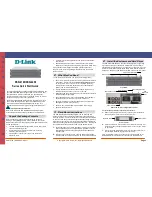
57
•
Node protection
—The PLR and the MP are connected through a device and the primary
CRLSP traverses this device. When the device fails, traffic is switched to the bypass tunnel. As
shown in
, the primary CRLSP is Router A—Router B—Router C—Router D—Router
E, and the bypass tunnel is Router B—Router F—Router D. Router C is the protected device.
This mode is also called next-next-hop (NNHOP) protection.
Figure 24 FRR node protection
DiffServ-aware TE
DiffServ is a model that provides differentiated QoS guarantees based on class of service. MPLS TE
is a traffic engineering solution that focuses on optimizing network resources allocation.
DiffServ-aware TE (DS-TE) combines DiffServ and TE to optimize network resources allocation on a
per-service class basis. DS-TE defines different bandwidth constraints for class types. It maps each
traffic class type to the CRLSP that is constraint-compliant for the class type.
The device supports these DS-TE modes:
•
Prestandard mode
—Proprietary DS-TE mode of Hewlett Packard Enterprise.
•
IETF mode
—Complies with RFC 4124, RFC 4125, and RFC 4127.
Basic concepts
•
CT
—Class Type. DS-TE allocates link bandwidth, implements constraint-based routing, and
performs admission control on a per class type basis. A given traffic flow belongs to the same
CT on all links.
•
BC
—Bandwidth Constraint. BC restricts the bandwidth for one or more CTs.
•
Bandwidth constraint model
—Algorithm for implementing bandwidth constraints on different
CTs. A BC model comprises two factors, the maximum number of BCs (MaxBC) and the
mappings between BCs and CTs. DS-TE supports two BC models, Russian Dolls Model (RDM)
and Maximum Allocation Model (MAM).
•
TE class
—Defines a CT and a priority. The setup priority or holding priority of an MPLS TE
tunnel for a CT must be the same as the priority of the TE class.
The prestandard and IETF modes of DS-TE have the following differences:
•
The prestandard mode supports two CTs (CT 0 and CT 1), eight priorities, and up to 16 TE
classes. The IETF mode supports four CTs (CT 0 through CT 3), eight priorities, and up to eight
TE classes.
•
The prestandard mode does not allow you to configure TE classes. The IETF mode allows for
TE class configuration.
•
The prestandard mode supports only RDM. The IETF mode supports both RDM and MAM.
•
A device operating in prestandard mode cannot communicate with devices from some vendors.
A device operating in IETF mode can communicate with devices from other vendors.
Router A
Router B
Router C
Router D
Router F
PLR
MP
Router E
Primary CRLSP
Bypass tunnel
Содержание FlexNetwork 5510 HI Series
Страница 9: ...vii Remote support 460 Documentation feedback 460 Index 462 ...
Страница 318: ...309 Request list 0 Retransmit list 0 ...
Страница 363: ...354 Verify that CE 1 and CE 2 can ping each other Details not shown ...
Страница 446: ...437 The MCE has redistributed the OSPF routes of the two VPN instances into the EBGP routing tables of PE 1 ...
















































